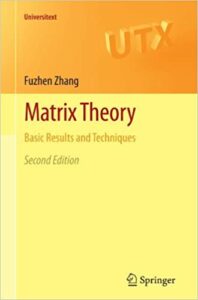Linear algebra and matrix theory is a difficult subject to learn, with the landscape of textbooks balkanized into matrix-oriented introductory texts oriented towards first- and second-year engineering and science students, vector space-oriented intermediate texts geared towards one of the first proof-based mathematics courses for a mathematics student, and more advanced texts like Bhatia’s Matrix Analysis which are demanding and challenging mathematical journeys intended for graduate students and researchers. For the student interested in numerical analysis and scientific computation, there can be a huge gap from, say, Gilbert Strang’s Introduction to Linear Algebra or Sheldon Axler’s Linear Algebra Done Right to Rajendra Bhatia’s Matrix Analysis.
Matrix Theory: Basic Results and Techniques by Fuzhen Zhang beautifully fills this gap.

I discovered the book by chance and was pleasantly surprised to find a book packed with useful insights. The book’s subtitle, basic results and techniques, is appropriate, as the book places a large emphasis on developing the reader’s “matrix kung-fu” as the author describes it. In a particularly striking example of this early in the book, Zhang furnishes four proofs that ![]() and
and ![]() have the same nonzero eigenvalues. This is an act of pedagogical brilliance that more textbooks would be wise to replicate. By presenting multiple proofs, the author shows the reader that there are often many paths to the same result. At the same time, Zhang shows the reader the benefit of having a wide toolbox by showing how one of the four methods is unable to give any information about the multiplicity of the eigenvalues, while the others are. Zhang’s careful focus on techniques is careful and illuminating, demonstrating many different examples when the proof technique is useful as well as examples where the technique falls short in solving a problem. Rather than merely teaching results, Matrix Theory teaches its reader tools with which to derive results.
have the same nonzero eigenvalues. This is an act of pedagogical brilliance that more textbooks would be wise to replicate. By presenting multiple proofs, the author shows the reader that there are often many paths to the same result. At the same time, Zhang shows the reader the benefit of having a wide toolbox by showing how one of the four methods is unable to give any information about the multiplicity of the eigenvalues, while the others are. Zhang’s careful focus on techniques is careful and illuminating, demonstrating many different examples when the proof technique is useful as well as examples where the technique falls short in solving a problem. Rather than merely teaching results, Matrix Theory teaches its reader tools with which to derive results.
One of the tools the book places emphasis on right from the start are block (or partitioned) matrices. To me, reasoning about matrices and linear operators by using ![]() blocks is an absolutely indispensable tool, which I only learned after having taken three courses on linear algebra. Here, the emphasis is appropriately on block matrices throughout the book, beginning with the second chapter which is entirely dedicated to this useful approach.
blocks is an absolutely indispensable tool, which I only learned after having taken three courses on linear algebra. Here, the emphasis is appropriately on block matrices throughout the book, beginning with the second chapter which is entirely dedicated to this useful approach.
The book has excellent coverage, stretching from introductory results through canonical forms to Kronecker and Hadamard products to sections on most important classes of matrices (e.g. nilpotent, tridiagonal, circulant, Vandermonde, Hadamard, doubly stochastic, nonnegative, unitary, contraction, positive (semi)definite, Hermitian, and normal matrices) to majorization and matrix inequalities. The book’s excellent exposition is complemented by an excellent suite of appropriately difficult exercises.
The book is a terrific reference on the tips and tricks of working with matrices and is excellent preparation for a more advanced monograph on matrix theory. I cannot endorse enough this underappreciated gem of a textbook.